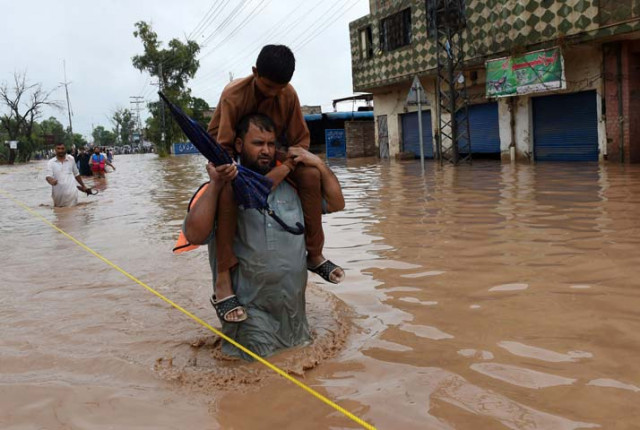
The Global Climate Risk Index, released by the Bonn-based advocacy group Germanwatch, ranks Pakistan eighth, two spots higher than last year’s 10th spot, on the list of countries most affected by the extreme weather in the last 20 years (1995 to 2014).
During these years, on an average, around 487 people were killed annually in weather-related incidents.
Monsoon floods: Damage to infrastructure estimated at Rs15 billion
Meanwhile, Pakistan features even higher on the Climate Risk Index for 2014. It ranks fifth on the list of nations most affected by the direct consequences of extreme weather events in 2014.
 Flood victims wade through a flooded area along a road as they wait for help, in Multan, September 13, 2014. PHOTO: REUTERS
Flood victims wade through a flooded area along a road as they wait for help, in Multan, September 13, 2014. PHOTO: REUTERSAfter low rainfalls in March 2014, which threatened food security of poor households in the country, heavy monsoon rains and floods in September caused 367 deaths, affected more than 2.5 million people and over 1 million acres of cropland.
The 2014 floods largely affected community infrastructure in Punjab and Azad Jammu and Kashmir, where more than 5,000 community development schemes were damaged, costing over Rs15 billion to the national exchequer.
2015 set to be hottest on record, 2016 even hotter due to El Niño
Every year, countries such as Pakistan and India are threatened by extreme weather events and remain in the bottom ten of the index, the report adds.
Honduras, Myanmar, Haiti top risk list, says climate group
Meanwhile, Honduras, Myanmar and Haiti top a new list of nations hardest hit by two decades of storms, floods, landslides and droughts that killed more than half a million people.
As climate impacts hit, Pakistan faces migration surge
Scientists point to the mounting threat from storms, floods, droughts and rising seas if mankind cannot brake emissions from heat-trapping greenhouse gases, especially from fossil fuels.
The report is a red-flag to negotiators from 195 countries trying to broker a global climate-saving pact in Paris.
Honduras, Myanmar and Haiti were the most afflicted by such disasters between 1995 and 2014, said the latest edition of the annual index.
Next were the Philippines, Nicaragua, Bangladesh, Vietnam, Pakistan, Thailand and Guatemala.
Altogether, more than 525,000 people died as a direct result of about 15,000 extreme weather events, the report said.
Losses amounted to more than $2.97 trillion (2.8 trillion euros), it said.
The analysis only looked at the direct results of extreme weather, it stressed, whereas the indirect consequences of extreme weather such as drought and famine resulting from heatwaves can be much more deadly.
It shows only one piece of the puzzle and is not a comprehensive index of vulnerability to climate change, researchers stressed.
For example, the study does not take into account sea-level rise, glacier melting or more acidic and warmer seas.
A growing body of research connects global warming and extreme weather, Germanwatch said.
"The Climate Risk Index thus indicates a level of exposure and vulnerability to extreme events that countries should understand as a warning to be prepared for more frequent and/or more severe events in the future," the report said.
Germanwatch urged negotiators at the November 30-December 11 UN climate conference in Le Bourget on the northern outskirts of Paris to reach a universal deal to avert a climate catastrophe.
"Paris needs to deliver a far-reaching and durable climate regime that safeguards affected populations," it warned.
Looking at 2014 alone, the Germanwatch study showed Serbia, Afghanistan and Bosnia suffered most from extreme weather events.
They were followed by the Philippines, Pakistan, Bulgaria, Nepal, Burundi, Bolivia and India.
Most of the countries who made it in the top 10 for extreme weather in 2014 had suffered "exceptional catastrophes," Germanwatch said.
But "over the last few years another category of countries has been gaining relevance: Countries that are recurrently affected by catastrophes such as the Philippines and Pakistan," it said.
Tolls from disasters are also affected by development strategies, such as population growth in vulnerable areas and protection against extreme events, experts also caution.


















COMMENTS
Comments are moderated and generally will be posted if they are on-topic and not abusive.
For more information, please see our Comments FAQ